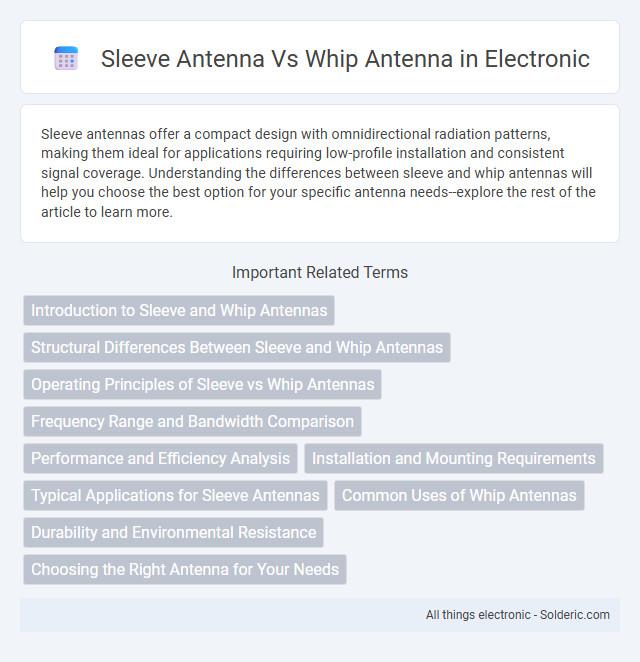Sleeve antennas offer a compact design with omnidirectional radiation patterns, making them ideal for applications requiring low-profile installation and consistent signal coverage. Understanding the differences between sleeve and whip antennas will help you choose the best option for your specific antenna needs--explore the rest of the article to learn more.
Comparison Table
| Feature | Sleeve Antenna | Whip Antenna |
|---|---|---|
| Design | Coaxial sleeve with a tubular radiator around the transmitter | Flexible rod-shaped antenna, usually a straight conductor |
| Frequency Range | Typically VHF/UHF bands | Broadband, covering VHF, UHF, and HF bands |
| Polarization | Vertical polarization | Vertical or variable depending on orientation |
| Radiation Pattern | Omnidirectional in the horizontal plane | Omnidirectional, often slightly directional depending on length |
| Size | Compact, typically shorter than whip antennas | Longer and flexible, size varies with frequency |
| Applications | Mobile communications, base stations, marine radios | Portable radios, vehicle-mounted, handheld transceivers |
| Durability | Sturdy, often enclosed for protection | Flexible but prone to bending or damage |
| Gain | Moderate gain suitable for short to medium distances | Variable gain, can be higher with longer whip |
| Installation | Fixed mounting, often requires coaxial feed | Simple mounting, can be handheld or mounted |
Introduction to Sleeve and Whip Antennas
Sleeve antennas consist of a conductive sleeve surrounding a coaxial feed line, providing improved impedance matching and reduced signal loss, commonly used in VHF and UHF applications. Whip antennas are simple, flexible monopole antennas made from a straight metal rod, often used for mobile and portable communication due to their omnidirectional radiation and ease of installation. Both antenna types serve distinct purposes based on their design, frequency range, and radiation patterns.
Structural Differences Between Sleeve and Whip Antennas
Sleeve antennas consist of a conductive tube surrounding a central conductor, often forming a coaxial structure with a quarter-wave radiator inside an outer sleeve, providing a balanced structure and stable impedance. Whip antennas are simple, flexible rods or wires, typically quarter-wave monopoles, extending vertically without any surrounding conductive elements, making them less complex in construction. The structural distinction lies in the sleeve's coaxial, enclosed design versus the whip's single, exposed conductor, impacting durability, radiation patterns, and installation methods.
Operating Principles of Sleeve vs Whip Antennas
Sleeve antennas operate using a balanced transmission line where the outer conductor acts as a sleeve around the inner radiating element, creating a quarter-wavelength resonant structure that efficiently radiates electromagnetic waves with omnidirectional patterns. Whip antennas function as monopole radiators, typically a straight rod or wire, designed to resonate at a quarter-wavelength, relying on the ground plane beneath to reflect and enhance the emitted signal. Understanding the operating principles of sleeve versus whip antennas helps you select the best option for applications requiring compactness and impedance matching (sleeve) or simplicity and ease of deployment (whip).
Frequency Range and Bandwidth Comparison
Sleeve antennas typically operate efficiently in the VHF to UHF frequency ranges, offering moderate bandwidth suitable for narrowband applications. Whip antennas cover a broader frequency spectrum, from HF through UHF bands, providing wider bandwidth and better adaptability for multi-frequency use. The choice between sleeve and whip antennas depends on specific frequency requirements and bandwidth needs, with whip antennas favored for broader frequency coverage.
Performance and Efficiency Analysis
Sleeve antennas typically offer enhanced performance in terms of bandwidth and impedance matching due to their balanced design, resulting in higher efficiency for UHF and VHF applications. Whip antennas, while simpler and more compact, often exhibit lower gain and reduced efficiency, especially in environments with limited space for optimal length extension. Comparative studies highlight that sleeve antennas maintain better radiation patterns and less signal loss, making them preferable for applications demanding consistent, high-performance wireless communication.
Installation and Mounting Requirements
Sleeve antennas typically demand precise installation with grounding considerations to ensure optimal performance, often requiring vertical mounting on conductive surfaces. Whip antennas offer more flexible mounting options, allowing installation on vehicles or portable devices without extensive grounding but may require a solid base or mounting bracket for stability. Your choice depends on the available mounting space and the need for stable electrical grounding during installation.
Typical Applications for Sleeve Antennas
Sleeve antennas are frequently used in mobile communication devices, GPS modules, and FM radio receivers due to their compact size and omnidirectional radiation pattern. Their ability to operate efficiently in VHF and UHF frequency bands makes them ideal for handheld radios and wireless communication systems. The integration of sleeve antennas in such applications enhances signal reliability and device portability.
Common Uses of Whip Antennas
Whip antennas are commonly used in mobile communications, including car radios, walkie-talkies, and portable handheld devices due to their simple design and efficient omnidirectional signal reception. Their flexibility and durability make them ideal for outdoor applications like amateur radio and emergency services where reliable, wide-range coverage is essential. Whip antennas excel in environments requiring a balance between performance and ease of installation compared to sleeve antennas.
Durability and Environmental Resistance
Sleeve antennas typically offer higher durability and better environmental resistance than whip antennas due to their rigid construction and enclosed design, which protects internal components from moisture, dust, and mechanical stresses. Whip antennas, often made from flexible metal rods, are more susceptible to bending, corrosion, and breakage under harsh weather conditions such as heavy wind or rain. The robust structure of sleeve antennas makes them suitable for outdoor and industrial applications where long-term reliability is critical.
Choosing the Right Antenna for Your Needs
Sleeve antennas offer compact size and good omnidirectional performance, ideal for applications requiring space efficiency and moderate range. Whip antennas provide longer reach and better signal penetration, making them suitable for environments needing higher gain and improved communication reliability. Assess your operational environment and device constraints to choose the antenna that best balances size, range, and signal quality for your specific needs.
sleeve antenna vs whip antenna Infographic

 solderic.com
solderic.com